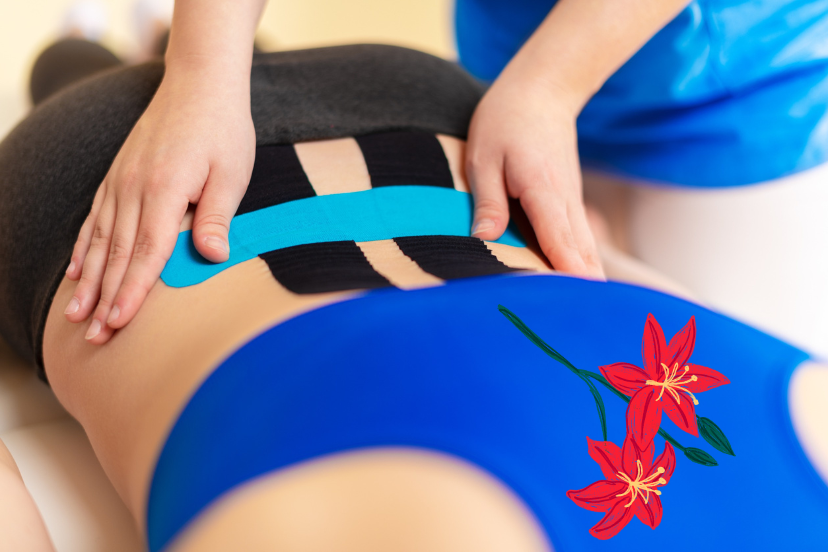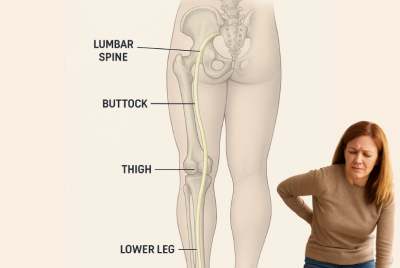KT Tape Sciatica Gluteus
Discover how KT tape sciatica gluteus can provide relief. Learn the taping technique used by therapists for effective support and recovery. KT tape can offer relief and support for sciatica and is not a substitute for comprehensive medical treatment. Following specific instructions is essential when using KT tape sciatica gluteus to ensure its effectiveness and safety. If your symptoms persist or worsen, seeking medical help for a proper diagnosis and treatment plan is crucial.
Understanding Sciatica And Gluteus Muscles
Sciatica and gluteus muscles are interconnected in a way that may influence your comfort and mobility. Understanding both these concepts is essential to manage any associated discomfort better.
What Is Sciatica?
Sciatica, in essence, refers to pain radiating along the path of the sciatic nerve, which branches from your lower back through your hips and buttocks and down each leg, knee, and feet. It’s commonly caused by a herniated disk or a bone spur on the spine compressing part of the nerve. This compression triggers inflammation, pain, and often some numbness in the affected leg.
What Are Gluteus Muscles?
The gluteus muscles are a group of three muscles which make up the buttocks: the gluteus maximus, gluteus medius, and gluteus minimus. They play a key role in maintaining balance, posture, and movement. Misalignment, overuse, or strain can result in discomfort in this area.
Understanding KT Tape
KT Tape is an elastic adhesive material that supports muscles and joints. It promotes better posture, enhances blood flow, and aids in pain relief and healing.
What Is KT Tape?
KT tape, short for Kinesiology Therapeutic Tape, is a strong elastic athletic tape used to support and relieve pain in muscles, joints, and ligaments. It mimics the elasticity of your skin and can stay in place for days at a time, providing ongoing support and relief.
How KT Tape Works
It works by lifting the skin slightly, creating a space between the skin and the tissues beneath it. This can help to reduce pressure and inflammation, promote better circulation, and facilitate healing.
KT (Kinesiology Therapeutic) Tape is an elastic sports tape designed to relieve pain while supporting muscles, tendons, and ligaments. It gently lifts the skin when applied correctly, creating a small space between the muscle and dermis layers. This space promotes better blood and lymphatic circulation, aiding in the reduction of swelling and speeding up recovery. Moreover, unlike conventional sports tapes, the tape provides support and stability to the targeted area without restricting movement. It can also help correct joint alignment and improve proprioception, the body’s ability to perceive its own position in space, thus potentially enhancing athletic performance.
Can KT Tape Help With Sciatic Nerve Pain?
KT Tape can effectively alleviate sciatic nerve pain when applied correctly. It stabilizes the sciatic nerve and surrounding muscles, reducing irritation and discomfort. The tape improves your postural alignment, which is crucial for managing sciatica symptoms. Its elastic properties support the affected area without restricting your range of motion, allowing you to continue with everyday activities and exercise. Lifting the skin slightly, KT Tape enhances blood circulation, promoting faster healing. Easy to apply and non-invasive, KT Tape is a practical option for those looking to manage their sciatic nerve pain.
KT Tape Gluteus Sciatica
KT Tape For Sciatica And Gluteus Muscles
KT Tape effectively supports individuals suffering from sciatica and gluteus muscle pain. Adhering directly to the skin helps stabilize the affected area, reducing stress on the muscles and nerves. Physiotherapists commonly recommend KT Tape to improve posture and alignment, which is essential for managing sciatica symptoms. It’s easy to apply, and its elastic properties allow for a full range of motion, making it ideal for everyday activities and exercise. The tape lifts the skin slightly, promoting better blood flow and speeding up the healing process. KT Tape is a non-invasive, convenient option for managing sciatica and gluteus muscle discomfort.
Where Do You Put KT Tape For Sciatica?
To target sciatica:
- Place KT Tape along the path of the sciatic nerve, starting from the lower back and extending toward the hip and down the leg.
- Position one strip horizontally over the most painful area and another vertically to provide additional support.
- Press firmly to ensure the tape adheres well.
Always consult a healthcare provider for proper application techniques.
Where Do You Put KT Tape On Your Glutes?
To tape your glutes:
- Start by identifying the area of pain or tension.
- Place one strip of KT Tape horizontally across the affected gluteus muscle.
- Add a second strip vertically, intersecting the first, for extra support.
- Press down firmly to make sure the tape adheres properly to the skin.
This placement aims to reduce muscle strain and improve posture. Always consult a healthcare provider for accurate application.
The Benefits Of Using KT Tape For Sciatica
Using KT tape can be a game-changer for managing sciatica pain. It provides support, reduces pressure on the nerve, can help control inflammation and improve circulation in the area, promoting quicker healing. KT Tape provides targeted relief for people dealing with sciatica pain. When applied correctly, it stabilizes the sciatic nerve and surrounding muscles, reducing irritation and discomfort. It improves postural alignment, a key element in treating sciatica symptoms. Unlike bulky braces, KT Tape allows for a full range of motion, facilitating everyday activities and exercise routines. The tape’s elastic properties support the affected area without restricting movement. Lifting the skin also enhances blood circulation, promoting faster healing. Its ease of application makes it a convenient, non-invasive alternative to other treatments. KT Tape offers practical and effective benefits for managing sciatica pain.
How To Apply KT Tape On Sciatica Gluteus
To apply KT Tape for sciatica in the gluteus, clean the skin first. Cut the tape into strips. Position one strip over the pain area and another vertically, offering support. Press firmly to adhere.
Step-By-Step Guide To KT Tape Application
Before applying KT Tape, clean the skin and trim any hair for better adherence. Here’s how you apply it:
1. Cut a strip of KT tape long enough to extend from the lower back to the thigh.
2. Apply the tape starting from the lower back, over the buttocks, and down to the thigh. Remember, the tape should not be stretched when applied over the point of pain.
3. Rub the tape gently to activate the adhesive.
Practical Tips For Using KT Tape
For effective KT Tape use, start with clean, dry skin. Measure and cut strips according to your needs. Apply the tape in patterns that target your specific pain points. Press firmly for secure adhesion—test the range of motion to ensure comfort and support.
Do’s And Don’ts For KT Taping
Ensure the skin is clean before applying. Don’t apply KT Tape on broken or irritated skin. Do rub the tape after application to activate the adhesive. Don’t stretch the middle of the tape; only stretch the ends if needed.
Do’s Tips For Using KT Tape
- Consult with a healthcare professional before starting.
- Ensure skin is clean, dry, and free of oils or lotions.
- Apply the tape an hour before physical activity.
- When applying, anchor the tape without stretch, apply the middle with stretch, and end without stretch.
- Rub the tape after application to activate the adhesive.
Don’ts Tips For Using KT Tape
- Don’t apply the tape on damaged or irritated skin.
- Don’t stretch the tape too much or too little. The optimum stretch is usually 25-50%.
- Don’t ignore severe or persistent pain.
- Don’t use it as a substitute for professional medical advice or treatment.
- Don’t remove it abruptly. Gently peel off in the direction of hair growth.
My Personal Experience And Recommendations

Sharing My Success Story With KT Tape
As a long-term sciatica sufferer, I found significant relief using KT tape. It provided support and eased the constant throbbing pain. I was able to move more freely and comfortably. Of course, it’s not a one-size-fits-all solution, but it’s worth giving it a try.
How To Tape For Sciatica Pain?
Taping can be a helpful adjunct in managing sciatica pain. Here’s a step-by-step guide:
- Clean and dry the affected area to ensure good tape adhesion.
- Start by placing a strip of athletic tape vertically along the length of the spine, extending from the lower back to the affected leg. This provides support and stability to the back.
- Apply a second strip horizontally, wrapping around the hip and crossing over the painful area. This helps to provide additional support and compression.
- Ensure the tape is snug but not too tight, as excessive pressure can lead to discomfort or circulation issues. It should allow for comfortable movement and breathing.
- For further support, you can add a third strip from the lower back diagonally across the buttock and down to the thigh. This can help alleviate tension and provide targeted support to the affected area.
- Smooth the tape gently to eliminate any wrinkles and ensure proper adhesion.
- Remember that taping is not a substitute for professional medical advice. It can offer temporary relief and support, but it’s essential to consult a healthcare professional for a comprehensive evaluation and treatment plan for sciatica pain.
Always listen to your body, and if the pain worsens or persists, seek medical attention promptly.
Physical Therapist And Taping
Physical therapists often utilize taping techniques as part of their treatment approach. Taping can be used to provide support, reduce pain, and enhance movement patterns. It is commonly employed in conditions like sprains, strains, and musculoskeletal injuries, including sciatica pain. By applying specialized athletic tape, physical therapists aim to promote proper alignment, stabilize joints, and alleviate pressure on affected areas. Taping techniques can vary depending on the specific needs and goals of the individual. Physical therapists are trained to assess and identify the appropriate taping method for each patient, considering the location of pain, range of motion, and functional limitations. While taping can offer temporary relief, it is typically combined with other physical therapy interventions, such as exercises, stretches, and manual techniques, to provide a comprehensive treatment plan for optimal recovery and improved function.
Kinesiology Taping – Kinesio Tape
Kinesiology taping, commonly known as Kinesio tape, is a technique used by physical therapists to aid in the healing process and reduce pain. Kinesio tape is a flexible and stretchable adhesive tape that is applied to the skin over affected muscles or joints. It is designed to provide support and stability while still allowing for a full range of motion. The tape’s elasticity can help improve blood and lymphatic circulation, reduce inflammation, and alleviate pressure on injured tissues. Physical therapists assess the specific needs of the individual and apply the tape accordingly, providing targeted support and promoting optimal healing and recovery.
Frequently Asked Questions (FAQs)
Is it safe to use KT tape for sciatica?
Yes, it’s safe to use KT tape for sciatica under proper guidance. The tape can help by providing support, reducing pressure on the nerve, and improving circulation in the affected area. However, it’s not a cure for underlying causes of sciatica. It should be used in conjunction with other treatments and always under a healthcare professional’s advice.
Does KT tape help with sciatica?
KT Tape can help with sciatica by stabilizing the affected area, improving posture, and reducing nerve irritation. It offers a non-invasive, convenient option for managing sciatica symptoms.
How long can I leave KT tape on?
Typically, KT tape can be left on for 3 to 5 days, even during showers. If you notice any irritation or discomfort, remove it immediately.
Where can I buy KT tape?
KT tape is widely available in sports stores, some pharmacies, and online platforms such as Amazon.
Can I apply KT tape by myself?
Yes, with some practice and by following instructions carefully, you can apply KT tape yourself. However, you may need assistance for hard-to-reach areas like the lower back.
Is KT tape gluteus sciatica painful?
Applying KT Tape for gluteus sciatica is generally not painful. The tape reduces discomfort by stabilizing the affected area and promoting better blood flow. However, consult a healthcare provider for personalized advice.
Does KT tape help with gluteus muscle pain?
Yes, KT tape can be applied to provide support and relieve pain in the gluteus muscles, similar to how it helps with sciatica pain.
Conclusion: Sciatica Pain Relief With KT Tape
In conclusion, KT Tape is a non-invasive, safe, and potentially effective way to manage and alleviate sciatica pain. It’s a tool that may help you get back to your daily activities with less discomfort. Everyone is unique, and what works for one may not work for all. It’s always best to consult a professional before trying any new treatment.
KT Tape can be a valuable tool for managing sciatica pain. By lifting the skin, it creates space to improve blood flow and reduce inflammation around the sciatic nerve. It also provides gentle support to the surrounding muscles, potentially easing the pressure on the nerve. This can help alleviate discomfort and enhance mobility without restricting movement. However, KT Tape is not a standalone treatment for sciatica. Using it as part of a comprehensive treatment plan, including physical therapy, exercises, and possible medical interventions, is crucial under professional guidance. Always consult with a healthcare provider for personalized advice.
Disclaimer
Please note that this article should not replace professional medical advice. Consult a healthcare professional for an accurate diagnosis and tailored treatment plan.
👉 Explore more:





